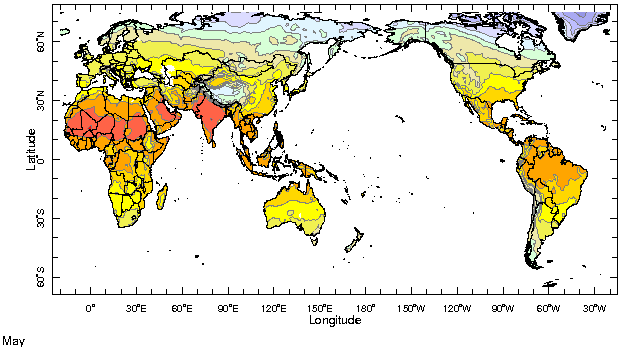|
IRI Climate Digest
June 2003
May Global Climate Summary
Climatological Background
In May, the sun is well into its march north of the equator (the maximum northward location will be achieved in June at 23.6 degrees north). Surface heating of the continents are setting the stage for summer monsoonal systems or northern hemisphere warm season rains. The lack of direct solar heating in the southern hemisphere creates a north-south temperature difference which strengthens mid-latitude storm tracks and the approach of winter.
Monthly Mean Temperature (1961-1990), data from the Climate Research
Unit, University of East Anglia


Monthly Mean Precipitation (1961-1990), data from the Climate Research
Unit, University of East Anglia


Temperatures
Highlights
Above average temperatures persisted across much of the tropics during May, with notably high temperatures over southern India. Unusually warm conditions returned to much of Europe, while the northeastern United States continued one of the coldest spring seasons seen in almost 20 years.
Temperature Difference from the 1961-1990 mean, with data
from NCEP Climate Prediction Center, CAMS.


Precipitation
Highlights
Drought conditions persist in eastern Australia and New Zealand and central and southern Europe see an unusually dry spring. Its been a mixed start to the rainy season in West Africa while flooding occurred in parts of the Greater Horn. Flood waters have begun to recede in northern Argentina but torrential rainfall in southern Sri Lanka brought some of the worst flooding in 50 years. May was also a very wet month in the eastern United States.
Precipitation Difference from 1961-1990 mean, with data
from NCEP Climate Prediction Center, CAMS-OPI.


Oceanic Conditions
Tropical Pacific: The recent decline in sea surface temperatures (SSTs) in the eastern and central tropical Pacific eased by the end of May but SSTs remain cooler than average across most of the region. Above average SSTs persist across western areas west of the dateline. Indicators are currently mixed as to whether current conditions will lead to a transition to La Niņa. See the latest IRI ENSO Update for a detailed summary and outlook.
Tropical Atlantic: Sea surface temperatures averaged near-normal in much of the central and eastern tropical Atlantic. Positive anomalies remain off the coast of central Africa and eastern South America.
Indian Ocean: Surface waters cooled slightly during May in parts of the basin but remained slightly warmer-than-normal across most of the northern and western portions.
Mid-latitudes: Warmer-than-normal SSTs persisted in the northern and western North Atlantic Ocean with below-average SSTs persisting in the South Atlantic between 40° and 50° south. Relatively warm SSTs also persisted in much of the southern Pacific.
Monthly Sea Surface Temperature Difference from the 1971-2000 mean,
with data from the Environmental Modeling Center, NCEP/NOAA.


Contents |
Special |
Impacts |
Climate |
Forecast
| 
